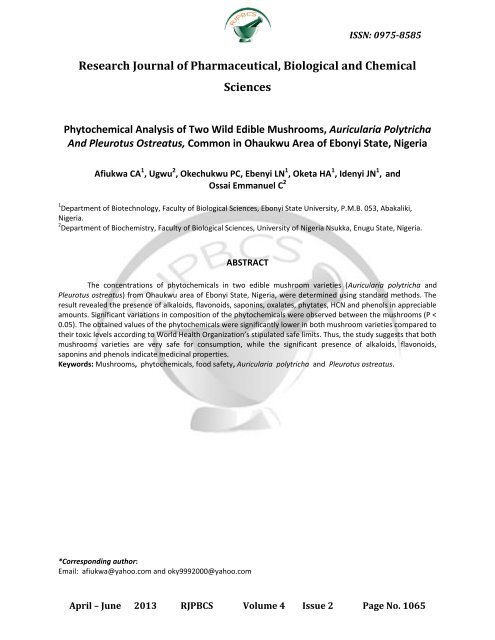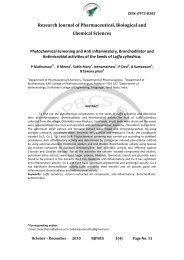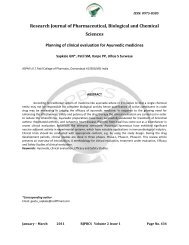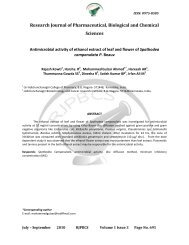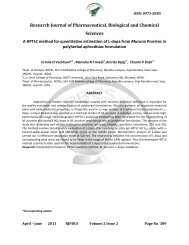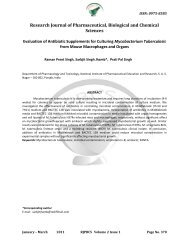Research Journal of Pharmaceutical, Biological and ... - RJPBCS
Research Journal of Pharmaceutical, Biological and ... - RJPBCS
Research Journal of Pharmaceutical, Biological and ... - RJPBCS
Create successful ePaper yourself
Turn your PDF publications into a flip-book with our unique Google optimized e-Paper software.
ISSN: 0975-8585permissible limit <strong>of</strong> (48.50mg/100g). The results suggest that these mushrooms could be safefor consumption.The flavonoid compositions <strong>of</strong> the two edible mushrooms are significantly lower thanthe tolerable limit (52.02mg/100g) (WHO, 2003), indicating that the mushrooms are equallysafe <strong>and</strong> could be good sources <strong>of</strong> anti-oxidants that boosts body immunity. The flavoniodcontents ranged from 0.07-0.33% with a mean value <strong>of</strong> 0.20 ± 0.15%.The results <strong>of</strong> the HCN contents <strong>of</strong> these edible mushroom varieties suggest thatPleurotus ostreatus is more poisonous than Auriuclaria polytricha in comparism <strong>of</strong> their HCN(Hydrogen cyanide) contents <strong>and</strong> need to be processed more properly before consumption. TheHCN contents were 6.86 <strong>and</strong> 4.20ppm with a mean value <strong>of</strong> 5.53 ± 1.46. The results indicatethat the HCN contents <strong>of</strong> these fungi differ significantly (p < 0.05). The values compare well withthe 5.8ppm reported by Chang (1994).The alkaloid contents <strong>of</strong> these edible mushrooms were 0.37 <strong>and</strong> 0.15% with an averagevalue <strong>of</strong> 0.26 ± 0.12%. The highest value was detected in Pleurotus ostreatus. The resultsshowed that the alkaloid concentrations <strong>of</strong> the edible mushrooms are lower than the WHO safeSt<strong>and</strong>ard limit <strong>of</strong> (61.00mg/100g) <strong>and</strong> also that there is a significant variation in the alkaloidcompositions <strong>of</strong> these fungi when compared (p < 0.05). The values obtained indicate that themushrooms are safe for consumption in large quantity <strong>and</strong> can help in relieving <strong>of</strong> pains.Oxalate concentrations <strong>of</strong> Pleurotus ostreatus <strong>and</strong> Auricularia polytricha ranged from0.22-0.41% with a mean value <strong>of</strong> 0.32 ± 0.11%. This shows that Pleurotus ostreatus recordedhigher oxalate content. The results are much lower compared to World Health Organizationtolerable limit <strong>of</strong> (105.00mg/100g) <strong>and</strong> this corroborated with the 0.412% reported by Harden[12].The results obtained in this study showed a significant difference in the phytatecompositions between the two edible mushroom varieties. The phytate content <strong>of</strong> Pleurotusostreatus <strong>and</strong> Auricularia polytricha are 0.29 <strong>and</strong> 0.15% respectively. These results are 100times lower than the st<strong>and</strong>ard safe limit (22.10mg/100g) [37].Phenol concentrations <strong>of</strong> these edible mushrooms from Ohaukwu Local GovernmentArea <strong>of</strong> Ebonyi State ranged from 0.06-0.22% with an average value <strong>of</strong> 0.14 ± 0.09%. Thisshowed that there was an appreciable variation <strong>of</strong> phenols in the mushrooms <strong>and</strong> theirconcentrations are lower than the World Health Organization St<strong>and</strong>ard safe limit. The resultsindicated that Auricularia polytricha had the highest value <strong>of</strong> (0.22%) against 0.06% detected inPleurotus ostreatus.CONCLUSIONThe phytochemical compositions observed in this study have shown the presence <strong>of</strong>some vital phytochemicals. The results showed that these edible mushroom varieties could beApril – June 2013 <strong>RJPBCS</strong> Volume 4 Issue 2 Page No. 1068
ISSN: 0975-8585safe for consumption as their various phytochemical concentrations were found to besignificantly lower than their world health organizations reported safe limits. The observedlevels suggest that these mushrooms would be a good source <strong>of</strong> some natural antibiotics <strong>and</strong>antioxidants. Therefore, consumption <strong>of</strong> these mushrooms in large quantity has no toxic effect<strong>and</strong> need to be domesticated owning to its nutritional <strong>and</strong> pharmacological essence.REFERENCES[1] Adesegun SA, <strong>and</strong> Coker HA. Nigeria <strong>Journal</strong> <strong>of</strong> <strong>Pharmaceutical</strong>s 2001; 32: 50-63.[2] Ali M, Shuja MN, Zahoor M, Qadri, I. African <strong>Journal</strong> <strong>of</strong> Biotechnology 2010; 9(11):1551-1554.[3] Asef MR. <strong>Journal</strong> <strong>of</strong> Mycology 2012; 5 (8): 222-310.[4] Beltran- Garcia, Miguel J, Estarron-Espinossa, Mirna <strong>and</strong> Oguro, Tetsuva. <strong>Journal</strong> <strong>of</strong>Agricultural <strong>and</strong> Food Chemistry 1997; 45(10): 4049.[5] Bingham RC. <strong>Journal</strong> <strong>of</strong> American Board <strong>of</strong> Botanists 1978; 17: 467-469.[6] Boa E. Food <strong>and</strong> Agriculture Organization <strong>of</strong> the United Nations 2004; 92 (5): 105-157.[7] Chang, shu-Ting <strong>and</strong> Philip G, miles. Mushroom: cultivation, nutritional value, medicinaleffect <strong>and</strong> environmental impact CRC press 1989; 4-6.[8] Chang Shu-Ting: miles <strong>and</strong> Philip G. Pleurotus a mushroom <strong>of</strong> broad adaptability.Mushroom cultivation, nutritional value, medicinal effect <strong>and</strong> environmental impact (2 ndedition). CRC press. 2004, pp.515-525.[9] Clarke ECC. The forensic chemistry <strong>of</strong> alkaloids, 3 rd edition marske H.F (editor) volumexii, academic press, New York 1999, pp. 514-590.[10] Elizabeth Speith. Auricularia polytricha (auriculanaceae). Hear species information 2011,pp.119.[11] Gunde-Cimerman AI. Experimental mycology 1995; 19(1): 1-6.[12] Haden M. Chlorophylls, in: chemistry <strong>and</strong> biochemistry <strong>of</strong> plant pigment, 6 th edition,(Godwin, T.W., editor). Academic press London 2007; 468-490.[13] Haden M. Chlorophylls. In: chemistry <strong>and</strong> biochemistry <strong>of</strong> plant pigment, 4 th edition,Godwin TW, (editor). Academic press, London 1997, pp. 462-488.[14] Hall Lan R. Growing mushrooms; the commercial reality (PDF). Lifestyle farmer(Auckl<strong>and</strong>, New Zeal<strong>and</strong>: rural press) 2010, pp. 42-45.[15] Harbone JB. Phytochemical method; A guide to London techniques to plant analysis. 4 thedition, charpman <strong>and</strong> Hall, London 2001, pp.270-284.[16] Hegnaur R. Comparative phytochemistry <strong>of</strong> alkaloids in comparative phytochemistry.Swain, T., (editor), Academic press, London 2001, pp.211-230.[17] Henry TA. The plant alkaloid 3 rd edition, Church Hill, London, 2002, pp.1-5.[18] ILSI. Flavonoids <strong>and</strong> hearth health: proceedings <strong>of</strong> the ILSI, North America flavonoidsworkshop, may 31-june, Washington (U.S.A) 2005, pp.55-109.[19] John Fereira. Mushroom industry USDA mannliberary, cornel, education 2010, pp.3-30.[20] Jones BA. Cyanogenic glycosides <strong>and</strong> their function in phytochemical ecology, 2 ndedition, Harborne, B (editor). Academic press London, 2007, pp.103-134.[21] Jordan P. Field guide to edible mushrooms <strong>of</strong> Britain <strong>and</strong> Europe. New Holl<strong>and</strong>publishers 2006, pp.10.April – June 2013 <strong>RJPBCS</strong> Volume 4 Issue 2 Page No. 1069
ISSN: 0975-8585[22] Kaufert F. The biology <strong>of</strong> Pleurotus corticatus fries. Minnesota Agricultural ExperimentStation Bulletin 1936, pp.114.[23] Majak EO <strong>and</strong> Pass WO. Quality control in food industry in food science <strong>and</strong> technologyseries <strong>of</strong> monographs, 2 nd edition. Academic press, London 1989, pp.408-500.[24] Manske RH. The alkaloid chemistry <strong>and</strong> physiology, Academic press New York 2006; 3:56-58.[25] Mattila P, Suonpan K <strong>and</strong> Piironen V. Functional properties <strong>of</strong> edible mushroomsnutrition 2000; 16(7-8): 694-696.[26] Nakakuki T. Pure <strong>and</strong> Applied Chemistry 2002; 74(7): 1245-1251.[27] Okuda T, Toshiba T <strong>and</strong> Hatano T. <strong>Journal</strong> <strong>of</strong> Science <strong>and</strong> Technology 1991; 5: 127-301.[28] Okwu DE <strong>and</strong> Ndu CU. International <strong>Journal</strong> <strong>of</strong> Molecular Medicine <strong>and</strong> Advance Science2006; 12 (2): 199-203.[29] Phillips, Roger. Mushrooms publisher Mcmilan 2006, pp. 226.[30] Rop O, Micek J <strong>and</strong> Jurikora T. Nutrition Reviews 2009; 67(11): 624-31.[31] Rubel W, <strong>and</strong> Arora D. <strong>Journal</strong> <strong>of</strong> Economic Botany 2008; 62(3): 223-243.[32] Saphr DL. Edible <strong>and</strong> medicinal mushrooms <strong>of</strong> New Engl<strong>and</strong> <strong>and</strong> Eastern Canada. NorthAtlantic Books, 2009, pp.643-795.[33] Stamets Paul. “Chapter 22: growth parameters for gurmet <strong>and</strong> medicinal mushroomspecies”. Growing gourmet <strong>and</strong> medicinal mushrooms (3 rd edition). Berkeley, California,U.S.A: ten speed press, 2000, pp.308-315.[34] Storey B, Noiles E <strong>and</strong> Thompson K. <strong>Journal</strong> <strong>of</strong> Cryobiology 1998; 37(1): 46-58.[35] Trease GE <strong>and</strong> Evans WC. Pharmacognosy len <strong>and</strong> fobiger 1983; 45-50.[36] Trudell S <strong>and</strong> Ammirati J. Mushrooms <strong>of</strong> the Pacific Northwest. Timber press field guidesPortl<strong>and</strong>, Oregon. Timber press 2009, pp.134.[37] World Health Organization. Post harvest <strong>and</strong> pressing technology <strong>of</strong> staple food.Technical compendium, WHO, Agricultural Science Bulletin 2003; 88: 171-172.April – June 2013 <strong>RJPBCS</strong> Volume 4 Issue 2 Page No. 1070


